
The Flash is the name of several superheroes appearing in American comic books published by DC Comics. Created by writer Gardner Fox and artist Harry Lampert, the original Flash first appeared in Flash Comics #1. Nicknamed "the Scarlet Speedster", all incarnations of the Flash possess "superspeed", which includes the ability to run, move, and think extremely fast, use superhuman reflexes, and seemingly violate certain laws of physics.

Motion blur is the apparent streaking of moving objects in a photograph or a sequence of frames, such as a film or animation. It results when the image being recorded changes during the recording of a single exposure, due to rapid movement or long exposure.
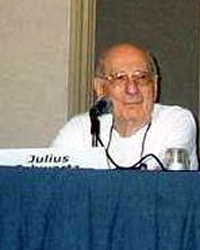
Julius "Julie" Schwartz was an American comic book editor, and a science fiction agent. He was born in The Bronx, New York. He is best known as a longtime editor at DC Comics, where at various times he was primary editor over the company's flagship superheroes, Superman and Batman.
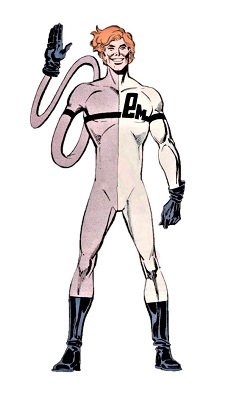
Elongated Man is a superhero appearing in American comic books published by DC Comics. He first appeared in The Flash #112.
John Broome, who additionally used the pseudonyms John Osgood and Edgar Ray Meritt, was an American comic book writer for DC Comics. Along with Gil Kane, he co-created the supervillain Sinestro.

Flash Comics is a comics anthology published by All-American Publications and later by National Periodical Publications. The title had 104 issues published from January 1940 to February 1949. Despite the title, the anthology featured the adventures of multiple superheroes in addition to Jay Garrick, the original Flash. Characters introduced in the series include the Flash, Hawkman, Hawkgirl and Black Canary.

Strange Adventures is a series of American comic books published by DC Comics, the first of which was August–September 1950, according to the cover date, and published continuously until November 1973.
Irwin Donenfeld was an American comic book publishing executive for DC Comics. Donenfeld co-owned the firm from 1948 to 1967, holding the positions of Editorial Director (1952–1957) and Executive Vice President. He was the son of Harry Donenfeld, co-founder of the company.

Carmine Infantino was an American comics artist and editor, primarily for DC Comics, during the late 1950s and early 1960s period known as the Silver Age of Comic Books. Among his character creations are the Black Canary and the Silver Age version of the Flash with writer Robert Kanigher, Elongated Man with John Broome, the Barbara Gordon incarnation of Batgirl with writer Gardner Fox, Deadman with writer Arnold Drake, and Christopher Chance, the second iteration of the Human Target, with Len Wein.

Murphy C. Anderson Jr. was an American comics artist, known as one of the premier inkers of his era, who worked for companies such as DC Comics for over fifty years, starting in the Golden Age of Comic Books in the 1940s. He worked on such characters as Hawkman, Batgirl, Zatanna, the Spectre, and Superman, as well as on the Buck Rogers daily syndicated newspaper comic strip. Anderson also contributed for many years to PS, the preventive maintenance comics magazine of the U.S. Army.
The Batman comic strip began on October 25, 1943, a few years after the creation of the comic book Batman. At first titled Batman and Robin, and briefly lengthened to Batman with Robin the Boy Wonder as a tie-in with the 1966 Batman television series, a later incarnation was ultimately shortened to Batman. The comic strip had three major and two minor runs in American newspapers.

Frank Giacoia was an American comics artist known primarily as an inker. He sometimes worked under the name Frank Ray, and to a lesser extent Phil Zupa, and the single moniker Espoia, the latter used for collaborations with fellow inker Mike Esposito.
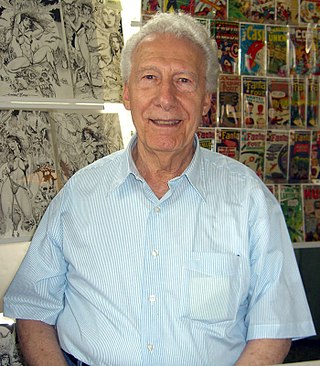
Joe Giella was an American comic book artist best known as a DC Comics inker during the late 1950s and 1960s period which historians and fans call the Silver Age of Comic Books. Due to his long and prolific career, Giella has been described as "one of the creators synonymous with the Silver Age of Comics."
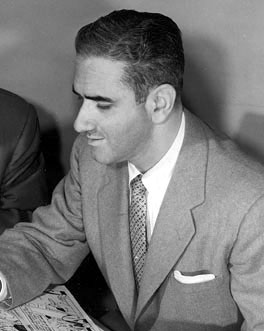
Bob Oksner was an American comics artist known for both adventure comic strips and for superhero and humor comic books, primarily at DC Comics.
The Alley Award was an American annual series of comic book fan awards, first presented in 1962 for comics published in 1961. Officially organized under the aegis of the Academy of Comic Book Arts and Sciences, the award shared close ties with the fanzine Alter Ego magazine. The Alley is the first known comic book fan award.
The Turtle is the name of two supervillains appearing in comic books published by DC Comics, who were primarily enemies of the Flash.

The Flash is an ongoing American comic book series featuring the DC Comics superhero of the same name. Throughout its publication, the series has primarily focused on two characters who have worn the mantle of the Flash: Barry Allen, the second Flash, and Wally West, the third Flash. The series began at issue #105, picking up its issue numbering from the anthology series Flash Comics which had featured Jay Garrick as the first Flash.

In intentional camera movement (ICM), a camera is moved during the exposure for a creative or artistic effect. This causes the image points to move across the recording medium, producing varied effects such as streaking, textures, and layers in the resulting image. The central idea in ICM photography is that motion serves as the primary compositional element. Strict technical or definitional arguments remain vague in this form of photography which has a long history and is connected with many other forms of photography, such as Impressionism and often blurs genres and styles.
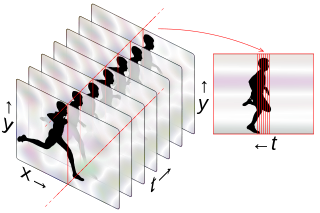
Strip photography, or slit photography, is a photographic technique of capturing a two-dimensional image as a sequence of one-dimensional images over time, in contrast to a normal photo which is a single two-dimensional image at one point in time. A moving scene is recorded, over a period of time, using a camera that observes a narrow strip rather than the full field. If the subject is moving through this observed strip at constant speed, they will appear in the finished photo as a visible object. Stationary objects, like the background, will be the same the whole way across the photo and appear as stripes along the time axis; see examples on this page.

All-Flash, originally published as All-Flash Quarterly, was a comic book magazine series published by All-American Publications and later National Periodicals featuring superhero Jay Garrick, the original Flash. The series was the first solo feature given to the Flash, who also appeared in the anthologies Flash Comics, All-Star Comics, and Comic Cavalcade. It ran for 32 issues from 1941 to 1947 and was originally published on a quarterly basis before changing over to a bi-monthly schedule with issue #6. Each issue regularly contained several stories featuring the Flash, as well as minor back-up features like Hop Harrigan, Butch McLobster, The Super Mobster, and Fat and Slat by cartoonist Ed Wheelan and, in later issues, Ton-O-Fun by Flash co-creator Harry Lampert.

















